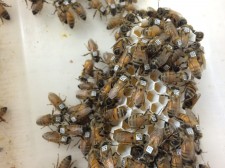Barcodes Enable Tracking the Flight of Honey Bees

URBANA, Ill., August 23, 2019 (Newswire.com) - Barcodes are all the buzz when it comes to identifying bees, thanks to research conducted by the University of Illinois’ Institute for Genomic Biology and Coordinated Science Lab.
Honey bees are important to global plant life, but studying their social behavior is tricky. It is difficult to tell one bee from another due to their small size, busy nature, and lack of distinguishing physical characteristics. Internationally renowned bee expert Gene Robinson, IGB Director and Swanlund Chair at Illinois, came up with the idea of using barcodes to tell bees apart from each other – a prospect that has many challenges, not the least of which is creating a barcode that is small enough to fit on a bee.
That is where CSL’s Lav Varshney comes in. Varshney and his collaborators at the National University of Singapore have established the fundamental limits of barcode design; in other words, they have determined how few symbols have to be in a barcode in order to reliably identify a bee.
“This work depends on identifying different bees using barcodes of a given size, given that the pictures of the bees may be noisy or obstructed in various ways,” said Varshney, coauthor on the recently accepted "The Bee-Identification Problem: Bounds on the Error Exponent." “One can think of images of barcodes as information-bearing signals, observed through noise, and so their optimal design is very much a mathematical problem.”
The team used information theory to determine upper and lower bounds for this math challenge. In addition, the group discovered that jointly decoding the identities of groups of bees was much more accurate than decoding the barcodes bee-by-bee.
The ability to determine the fundamental limits of barcodes and identification as a concept can be applied to other research in the animal kingdom and outside of it. One particular setting Varshney is interested in is the “penguin identification problem.”
“Penguins incubate their eggs on their feet: the mother and father take turns incubating and retrieving food from the ocean,” Varshney, assistant professor of electrical and computer engineering (ECE), explained. “Penguins, however, have trouble telling each other apart in a colony just by looking, so they have special calls to identify their mates. I’m curious to know the information-theoretic limits of such identifying calls.”
The work could also apply to identifying warehouse products labeled with RFID barcodes using wide-area sensors.
While Varshney plans to continue to determine the fundamental limits in other areas of research, he hasn’t left the bees behind. His research group is now aiming to work with Robinson’s to determine the best decoding algorithms for practical bee barcodes themselves and looking at what the theoretical limits of decoding are for studying the overall social network of bees.
“I’m very happy that ECE student Augustine Koh connected me to Gene Robinson,” said Varshney. “Learning of the practical instrumentation problems they face in studying the genetic correlates of social behavior inspired some intriguing new theory that we will build on going forward.”
Source: University of Illinois at Urbana-Champaign